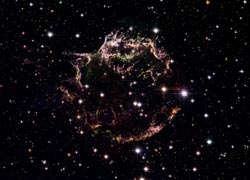Cassiopeia A – The colourful aftermath of a violent stellar death

The colourful aftermath of a violent stellar death A new image taken with the NASA/ESA Hubble Space Telescope provides a detailed look at the tattered remains of a supernova explosion known as Cassiopeia A (Cas A). It is the youngest known remnant from a supernova explosion in the Milky Way. The new Hubble image shows the complex and intricate structure of the star’s shattered fragments.
The image is a composite made from 18 separate images taken using Hubble’s Advanced Camera for Surveys (ACS), and it shows the Cas A remnant as a broken ring of bright filamentary and clumpy stellar ejecta. These huge swirls of debris glow with the heat generated by the passage of a shockwave from the supernova blast. The various colours of the gaseous shards indicate differences in chemical composition. Bright green filaments are rich in oxygen, red and purple are sulphur, and blue are composed mostly of hydrogen and nitrogen.
A supernova such as the one that resulted in Cas A is the explosive demise of a massive star that collapses under the weight of its own gravity. The collapsed star then blows its outer layers into space in an explosion that can briefly outshine its entire parent galaxy. Cas A is relatively young, estimated to be only about 340 years old. Hubble has observed it on several occasions to look for changes in the rapidly expanding filaments.
In the latest observing campaign, two sets of images were taken, separated by nine months. Even in that short time, Hubble’s razor-sharp images can observe the expansion of the remnant. Comparison of the two image sets shows that a faint stream of debris seen along the upper left side of the remnant is moving with high speed – up to 50 million kilometres per hour (fast enough to travel from Earth to the Moon in 30 seconds!).
Cas A is located ten thousand light-years away from Earth in the constellation of Cassiopeia. Supernova explosions are the main source of elements more complex than oxygen, which are forged in the extreme conditions produced in these events. The analysis of such a nearby, relatively young and fresh example is extremely helpful in understanding the evolution of the Universe.
Media Contact
More Information:
http://www.spacetelescope.org/news/html/heic0609.htmlAll latest news from the category: Physics and Astronomy
This area deals with the fundamental laws and building blocks of nature and how they interact, the properties and the behavior of matter, and research into space and time and their structures.
innovations-report provides in-depth reports and articles on subjects such as astrophysics, laser technologies, nuclear, quantum, particle and solid-state physics, nanotechnologies, planetary research and findings (Mars, Venus) and developments related to the Hubble Telescope.
Newest articles

Properties of new materials for microchips
… can now be measured well. Reseachers of Delft University of Technology demonstrated measuring performance properties of ultrathin silicon membranes. Making ever smaller and more powerful chips requires new ultrathin…

Floating solar’s potential
… to support sustainable development by addressing climate, water, and energy goals holistically. A new study published this week in Nature Energy raises the potential for floating solar photovoltaics (FPV)…

Skyrmions move at record speeds
… a step towards the computing of the future. An international research team led by scientists from the CNRS1 has discovered that the magnetic nanobubbles2 known as skyrmions can be…





















